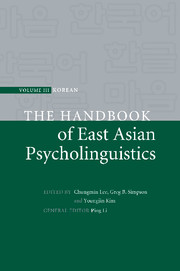Book contents
- Frontmatter
- Contents
- List of figures
- List of tables
- List of contributors
- Preface
- Introduction: Advances in Korean psycholinguistics
- Part I Language acquisition
- Part II Language processing
- 28 Visual processing of Hangul, the Korean script
- 29 English vowel spaces produced and perceived by Americans and Koreans
- 30 Morphological representation and processing of Sino-Korean words
- 31 The role of phonology in word recognition of Korean Hangul and Hanja
- 32 Lexical and sublexical processes in Korean word recognition
- 33 Prosody in sentence processing
- 34 Korean sentence processing
- 35 Sentence processing and memory representation in Korean
- 36 Understanding complex sentences: memory constraints and informational structure
- 37 ERP studies of Korean language processing: word-order effects
- 38 Inferences during discourse comprehension in Korean
- 39 Morpho-syntactic processing in Korean aphasics
- 40 Morpho-syntactic processing of Korean-speaking adults with Broca's aphasia
- 41 Comprehension deficits in Korean agrammatic aphasia
- 42 Developmental reading disorders in Korean
- 43 Individual differences in Korean language processing: context-dependent processing of skilled readers in word ambiguity resolution
- 44 A computational model of lexical and morphological processing in Korean
- References
- Name index
- Subject index
44 - A computational model of lexical and morphological processing in Korean
from Part II - Language processing
Published online by Cambridge University Press: 05 June 2012
- Frontmatter
- Contents
- List of figures
- List of tables
- List of contributors
- Preface
- Introduction: Advances in Korean psycholinguistics
- Part I Language acquisition
- Part II Language processing
- 28 Visual processing of Hangul, the Korean script
- 29 English vowel spaces produced and perceived by Americans and Koreans
- 30 Morphological representation and processing of Sino-Korean words
- 31 The role of phonology in word recognition of Korean Hangul and Hanja
- 32 Lexical and sublexical processes in Korean word recognition
- 33 Prosody in sentence processing
- 34 Korean sentence processing
- 35 Sentence processing and memory representation in Korean
- 36 Understanding complex sentences: memory constraints and informational structure
- 37 ERP studies of Korean language processing: word-order effects
- 38 Inferences during discourse comprehension in Korean
- 39 Morpho-syntactic processing in Korean aphasics
- 40 Morpho-syntactic processing of Korean-speaking adults with Broca's aphasia
- 41 Comprehension deficits in Korean agrammatic aphasia
- 42 Developmental reading disorders in Korean
- 43 Individual differences in Korean language processing: context-dependent processing of skilled readers in word ambiguity resolution
- 44 A computational model of lexical and morphological processing in Korean
- References
- Name index
- Subject index
Summary
Abstract
Lexical processing plays an important role in language comprehension. After word recognition, necessary knowledge for further language processing, such as word meaning, syntactic category, and usage information, is available. For example, in order to comprehend the structure of a sentence, the syntactic category information of the component word presented in the sentence is necessary. In this paper, we review major issues that have been addressed in Korean word recognition research, and propose a computational model to explain Korean word recognition. The organization of the chapter is as follows: first, we briefly introduce some experimental results in Korean word recognition and morphological processing research. We will focus on studies regarding word frequency, word length, neighborhood effects, form priming, and morphological processing. Second, a computational model for Korean word recognition will be presented. The computational model was proposed to explain the characteristics of Korean morphological representation and processing. However, this computational model can explain other lexical effects such as word frequency, word length, and form priming effects. Third, the simulation results of the computational model will be shown and discussed. We will compare the simulation results with human data to evaluate how well the model simulates Korean word processing and how much the simulated results coincide with that of human processing. We also discuss both the strengths and weaknesses of the computational model.
Linguistic characteristics in Korean lexical processing
A Korean sentence consists of major phrases, which are composed of Eojeols.
- Type
- Chapter
- Information
- The Handbook of East Asian Psycholinguistics , pp. 538 - 546Publisher: Cambridge University PressPrint publication year: 2009
- 1
- Cited by



